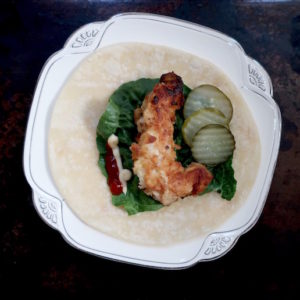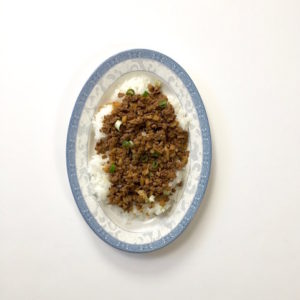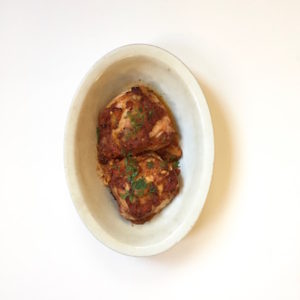Hot Sauce at Home (Fake Sriracha)
The world divides into two kinds of people: those who must have Huy Fong Sriracha Sauce with every meal, and those who think people like us are lunatics .

Well, pity us Sriracha lovers, for the rooster has fled the coop. And nobody knows when the bird will return.

More accurately, Huy Fong is blaming shortages of their beloved product on global warming, which has impacted their ability to acquire adequate amounts of hot peppers. Ergo, no Sriracha sauce. Market shelves are bare. People have resorted to stealing bottles from restaurants (!). Meanwhile, at this writing–July 13, 2023–two 17 ounce bottles of Huy Fong Sriracha Sauce will cost you $85.60 at Walmart.

Well, I thought to myself, there’s always shatta, the Middle Eastern answer to Sriracha. Made from hot red or green peppers, vinegar, and nothing else, shatta is that rare commercial product that is truly spicy.

Berkeley Bowl Market devotes an entire aisle to commercial hot sauce, which is rather like barbecue sauce: commercial products are bottled in a cacophony of colorful labels, often using extreme fonts, boasting even more extreme ingredients.

Nothing fancy.
True spice heads eschew all this frippery. We want heat, and we want it from peppers. The rest, to quote the music writer Alex Ross wildly out of context, is noise. So it was the many, many bottle boasting their heat indices, secret recipes, and assurances their product would blow away body parts on contact sat untouched while the shatta, a simple, unassuming product edging shoppers from hot sauce into Middle Eastern foods, was clean sold out.
I did not photograph this.
So it was I found myself forced to create a substitute hot sauce at home. Fortunately it is summertime, and fresh peppers may be found locally.

What follows is not an attempt to replicate Sriracha. Rather, it is an attempt to create a hot sauce to tide me–and my fellow hot sauce lovers–over until the real thing returns.
Whenever that may be.
—
A few notes.
My hot sauce uses a blend of red or yellow bell pepper, jalapeno pepper, and Scotch Bonnet pepper. Jalapenos and Scotch Bonnets are extremely hot, so wear gloves when handling them. Don’t touch your eyes, face, lips, or other sensitive areas while handling them. It’s easy to forget what you’re doing, and believe me, we all do it once. Hot soapy water is your friend. If you irritate your eyes, rinse repeatedly with cool water.

Hot peppers give off fumes while cooking. Said fumes can cause coughing and sneezing. Open your windows and run your oven’s exhaust fan, if you have one (or it works; mine does not.).

Did you really want a photo of me coughing and sneezing? I didn’t think so.
I did not ferment the peppers, because fermenting takes time I didn’t have. I need hot sauce now.

When the models look like this, all you do is show up.

If you do sample peppers or sauce and find yourself unhappily wishing for a fire extinguisher, rice, not water, is the fastest way to calm the flames.

A jam funnel, pictured below, helps transfer sauces, jams, and other preserves from pan to jar.

A word about the final color of your hot sauce. Red bell peppers will give you a lovely orange red result, like this:

Yellow bells give a less aesthetic result, but taste just as good. Do not be deterred.

Use your hot sauce anywhere you would use Huy Fong Sriracha: on eggs, sandwiches, rice, to perk up dips, on meats. Mix it with sour cream and dip chips into it. If this makes you nervous, dip vegetables into it instead, and call it healthy.
Hot Sauce
Prep time: about 45 minutes
Yield: approximately 4 ounces, or 60 ml hot sauce.
You will need a small food processor, blender, or stick blender to make the hot sauce. You’ll also need a wok or large frying pan, a knife, tongs or a fork, and a lidded glass jar or other sterile lidded storage vessel.
If you haven’t any automated gizmos to puree the sauce, you can use a potato masher in a bowl. Be careful not to splatter yourself. For this reason I don’t think mortar and pestle are wise.
Take care when handling hot peppers. Wash utensils and cutting boards with hot soapy water. Open windows and use the oven fan, if you have one. Keep pets and small children away from the peppers. Disposable or washable gloves are recommended while preparing hot sauce.
1 red or yellow bell pepper
1 shallot
1 or 2 small garlic cloves (optional)
1 red or green Jalapeno pepper
1 Scotch Bonnet pepper
2-3 tablespoons peanut or other mild cooking oil, like grapeseed
1 teaspoon fine salt, plus more to taste, if needed
1 teaspoon rice wine or other mild vinegar
a little water, for loosening the puree
Sterilize a lidded glass jar that will easily hold 4 ounces/60 ml. Wash it with hot soapy water and either put it in a 200F/170C oven to dry (the lid can rest on a dishtowel) or run it through your dishwasher.
Have a wok or large frying pan ready.
Slice the red or yellow pepper into “slabs” and deseed it.
Slice the shallot thinly, discarding the papery outer layer.
Lightly crush and slice garlic, if using.
Don gloves.
Slice the Scotch Bonnet pepper. For a spicy sauce, leave seeds and ribs in. For a mild sauce, remove seeds and ribs.
Slice Jalapeno Pepper; For a spicy sauce, leave seeds and ribs in. For a mild sauce, remove seeds and ribs.
Strip off gloves and discard/wash them.
Pour cooking oil into pan or wok and turn heat to low. I used my 14 inch/28cm wok to make the hot sauce.
Once pan is warm, add peppers, shallots, and garlic. Use tongs or large fork to transfer peppers to pan, so you aren’t handling them. Scatter a teaspoon of salt over all.
You want the heat to be just high enough for peppers/shallots/garlic to cook gently without browning. Cook for 15-20 minutes, stirring frequently to avoid browning.You may need to adjust the burner frequently to keep the heat at the right temperature. I did.
The peppers should begin to cook down and soften. I used the spatula to break peppers down further in the pan.
The entire cooking process takes 15-20 minutes. You’re looking for the peppers and shallots to collapse and soften without completely losing their shapes or colors.
Turn off the heat and let the mixture cool a few minutes.
At this point I wash the cutting board and knife with hot soapy water. If you’re concerned about lingering heat, rub your board with a cut lemon or scrub with coarse salt.
Carefully pour the sauce into the processor cannister, or whatever you’re using to puree the sauce. Taste a tiny bit for salt, and add if needed. You will likely need to add a little water.
Decant the sauce into the sterilized jar. Add a teaspoon of vinegar on top.
Cap jar loosely and allow to cool on counter for about 20 minutes. (Hot jar+Cold Fridge=Bad idea) Once the jar is cool, tighten lid and refrigerate. Use sauce within 2 weeks.
Note:
This sauce is not intended for long keeping. It should be refrigerated and consumed within a couple weeks.




